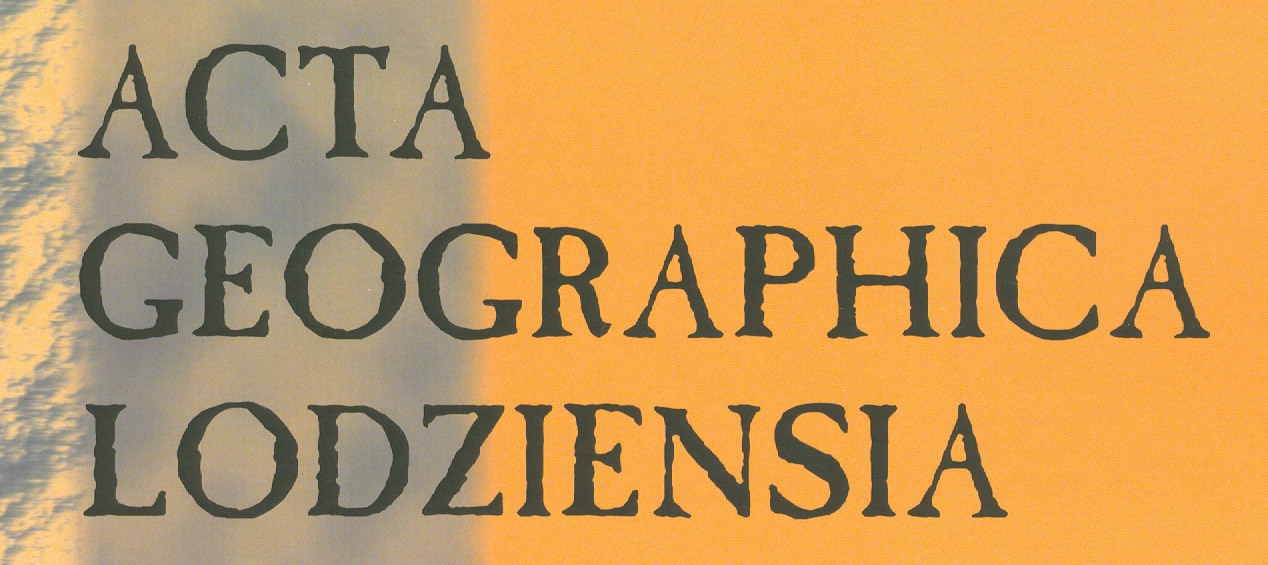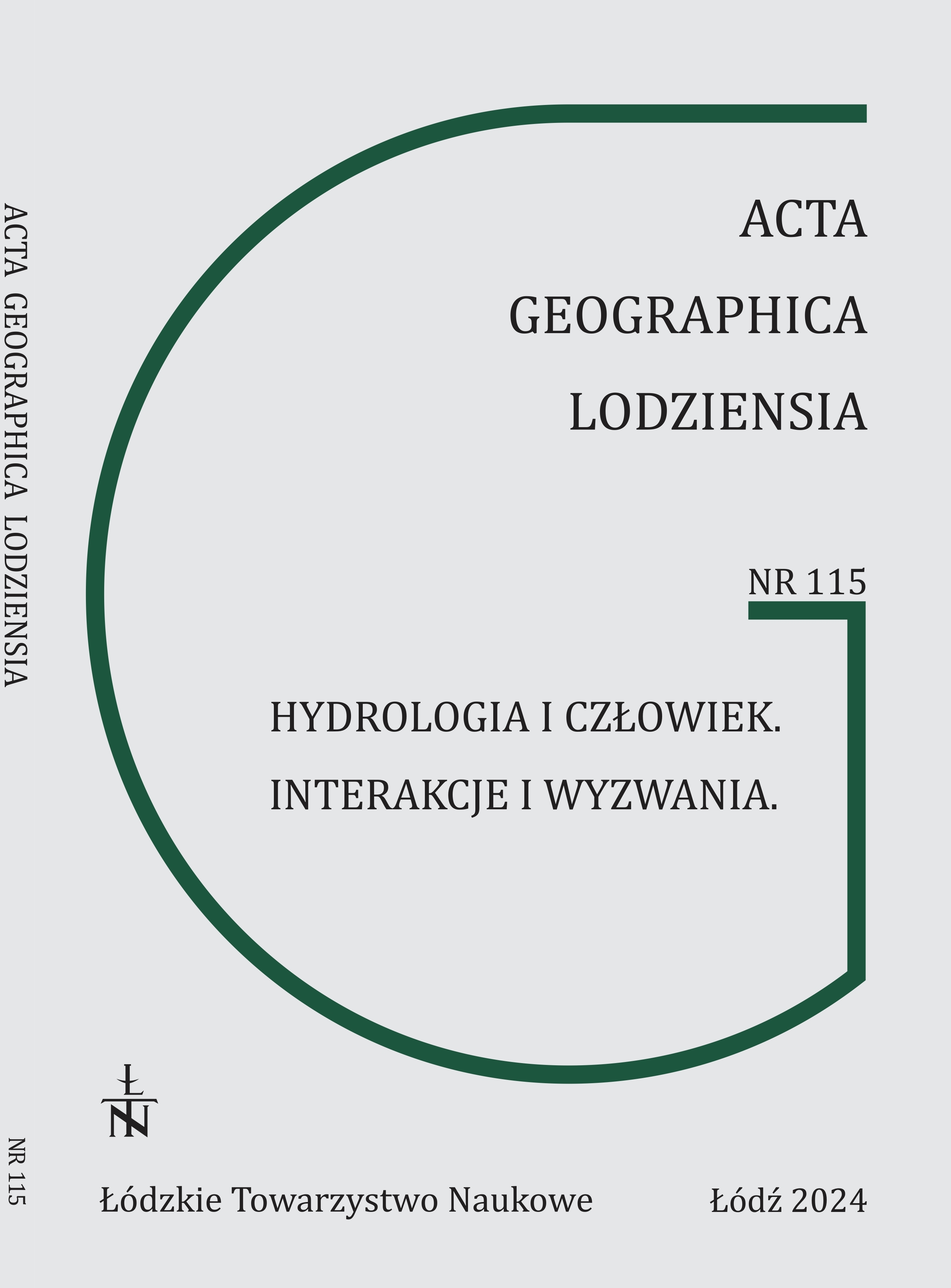Uwarunkowania i zmienność niżówek rzecznych w wybranych regionach geograficznych Polski w latach 1989–2018
DOI:
https://doi.org/10.26485/AGL/2024/115/3Słowa kluczowe:
zmiany wieloletnie, zmiany sezonowe, trendy, niedobory odpływuAbstrakt
Celem opracowania była identyfikacja i ocena zmienności niżówek rzecznych w pięciu dużych zlewniach w Polsce, które z uwagi na wielkość i położenie odzwierciedlają wiodące cechy regionów fizycznogeograficznych, w których się znajdują. Do badań wytypowano 92 przekroje wodowskazowe posiadające serie przepływów dobowych z okresu 1989–2018. Dane zaczerpnięto z bazy IMGW-PIB. Niżówki zidentyfikowano w oparciu o stały w wieloleciu przepływ graniczny, odpowiadający 70. percentylowi z krzywej czasów trwania przepływu wraz z wyższymi. Ocenie poddano wieloletnią i sezonową zmienność czasów trwania niżówek oraz niedoborów odpływu niżówkowego, a także ich miar pochodnych. Przeprowadzone analizy wykazały związek rozkładu opadów i struktury bilansu wodnego z przeciętnym czasem trwania oraz liczbą identyfikowanych epizodów. Wskazano na specyficzne cechy zlewni determinujące rozwój przepływów niżówkowych. Wynikały one przede wszystkim z cech struktury hydrogeologicznej i hydrograficznej zlewni, pokrycia terenu i natężenia ewapotranspiracji. Zwrócono uwagę na kształtowanie sezonowych cech niżówek rzecznych, zarówno w aspekcie ich genezy, jak i dynamiki rozwoju. Zidentyfikowano główne czynniki antropogeniczne oddziałujące na przebieg przepływów niżówkowych.
Bibliografia
Bobiński B., Meyer W. 1992. Susza w Polsce w latach 1982–1992. Ocena hydrologiczna. Wiadomości Instytutu Meteorologii i Gospodarki Wodnej 4: 3-24.
Cammalleri C., Vogt J., Salamon P. 2017. Development of an operational low-flow index for hydrological drought monitoring over Europe. Hydrological Sciences Journal 62(3): 346-358.
Chełmicki W., Bieńkowski T. 2005. Przepływy niżówkowe w dorzeczu górnego Dunajca w 2003 roku na tle wielolecia 1951–2003. Folia Geographica. Seria Geographica Physica 35: 65-75.
Choi W., Borchardt S.A., Choi J. 2022. Human Influences and Decreasing Synchrony between Meteorological and Hydrological Droughts in Wisconsin Since the 1980s. Annals of the American Association of Geographers 112(1): 36-55.
Choiński A. 2017. Geneza i rozmieszczenie jezior. W: P. Jokiel, W. Marszelewski, J. Pociask-Karteczka (red.) Hydrologia Polski. PWN, Warszawa: 223-229.
Ciepielowski A., Kaznowska E. 2007. A Description of Hydrological Droughts in the Białowieża Primeval Forest in the Years 2003–2005. Geographia Polonica 80(2): 125-136.
Dębski K. 1970. Hydrologia. Arkady, Warszawa.
Dhawale R., Paul S., George J.S. 2023. Water balance analyzis using Palmer Drought Severeity Index for drought-prone region of Marathwada, India. International Journal of River Basin Management 21(4): 731-742.
Dierauer J.R., Allen D.M., Whitfield P.H. 2021. Climate change impacts on snow and streamflow drought regimes in four ecoregions of British Columbia. Canadian Water Resources Journal 46(4): 168-193.
Dubicki A. (red.). 2002. Zasoby wodne w dorzeczu górnej i środkowej Odry w warunkach suszy. Wyd. IMGW, Warszawa
Farat R., Kępińska-Kasprzak M., Kowalczyk P., Mager P. 1995. Susze na obszarze Polski w latach 1951–1990. Materiały Badawcze Instytutu Meteorologii i Gospodarki Wodnej, Gospodarka Wodna i Ochrona Wód 16.
Fleig A.K., Tallaksen L.M., Hisdal H., Hannah D.M. 2010. Regional hydrological drought in north-western Europe: linking a new Regional Drought Area Index with weather types, Hydrological Processes, online w Wiley Inter-Science.
Graf R. 2015. Reference statistics for the structure of measurement series of groundwater levels (Wielkopolska Lowland, western Poland). Hydrological Sciences Journal 60(9): 1587-1606.
Han J., Singh V.P. 2023. A review of widely used drought indices and the challenges of drought assessment under climate change. Environmental Monitoring and Assessment 195: 1-25.
Hannaford J., Lloyd-Hughes B., Keef C., Parry S., Prudhomme C. 2011. Examining the large-scale spatial coherence of European drought using regional indicators of precipitation and streamflow deficit. Hydrological Processes 25: 1146-1162.
Hisdal H. 2009. Streamflow deficit. W: S. Demuth, A. Gustard (red.) Manual on low-flow. Estimation and Prediction. Operational Hydrology Report No. 50. WMO Publication No. 1029, Geneva: 71-76.
Hisdal H., Tallaksen L.M., Peters E., Stahl K., Zaidman M. 2001. Drought Event Definition, W: S. Demuth, K. Stahl (red.) Assessment of the Regional Drought Impact of Droughts in Europe. Institute of Hydrology, University of Freiburg: 17-26.
Hisdal H., Tallaksen L.M., Clausen B., Peters E., Gustard A. 2004. Hydrological Drought Characteristics. W: L.M. Tallaksen, H.A.J. van Lanen (red.) Hydrological Drought. Processes and Estimation Methods for Streamflow and Groundwater. Developments in Water Science 48, Elsevier, Amsterdam: 139-198.
Jaguś A., Rzętała M. 2000. Zbiornik Poraj: charakterystyka fizycznogeograficzna. Wydział Nauk o Ziemi, Uniwersytet Śląski, Sosnowiec.
Jańczak J., Kowalik A., Sziwa R. 1994. Reakcja stanów wody jezior dorzecza Odry na suszę lat 1989–1992. Wiadomości Instytutu Meteorologii i Gospodarki Wodnej 2: 117-124.
Jokiel P. 1994. Zasoby, odnawialność i odpływ wód podziemnych strefy aktywnej wymiany w Polsce. Acta Geographica Lodziensia 66–67.
Jokiel P., Bartnik A. 2020. Ner. Monografia hydrologiczna niekochanej rzeki. Wyd. Uniwersytetu Łódzkiego, Łodź.
Kasprzyk A. 2010. Prawdopodobieństwo wystąpienia niżówek w zlewniach rzek województwa świętokrzyskiego. W: T. Ciupa, R. Suligowski (red.) Woda w badaniach geograficznych. Wyd. Uniwersytetu Jana Kochanowskiego, Kielce: 273-208.
Kozek M. 2018. Spatial variability of low-flows in the upper Warta river catchment. Acta Scientiarum Polonorum – Seria Formatio Circumiectus 17(3): 67-76.
Kozek M., Tomaszewski E. 2019. Spatial development of hydrological droughts in lake catchments. Limnological Review 19(4): 159-174.
Kozek M., Tomaszewski E. 2022. Dynamics of hydrological droughts propagation in mountainous catchments. Miscellanea Geographica, Regional Studies on Development 26(2): 111- -124.
Kożuchowski K.M. 2017. Opady atmosferyczne. W: P. Jokiel, W. Marszelewski, J. Pociask-Karteczka (red.) Hydrologia Polski. PWN, Warszawa: 36-44.
Laaha G. 2002. Modelling summer and winter droughts as a basis for estimating river low flows. W: FRIEND 2002 – Regional Hydrology: Bridging the Gap between Research and Practice (Proceedings of the Fourth International FRIEND Conference held at Cape Town, South Africa, March 2002), IAHS Publication 274: 289-295.
Michalczyk Z., Chmiel S., Chmielewski J., Turczyński M. 2007. Hydrologiczne konsekwencje eksploatacji złoża węgla kamiennego w rejonie Bogdanki (LZW). Biuletyn Państwowego Instytutu Geologicznego 422: 113-126.
Mioduszewski W., Ślesicka A., Querner E. 2004. Warunki zasilania doliny dolnej Biebrzy, Woda–Środowisko–Obszary Wiejskie 4, 1(10): 67-78.
Mukhawana M.B., Kanyerere T., Kahler D., Masilela N.S., Lalumbe L., Umunezero A.A. 2024. Hydrological drought assessment using the standardized groundwater index and the standardized precipitation index in the Berg River Catchment, South Africa. Journal of Hydrology: Regional Studies 53: 1-17.
Ogunrinde A.T., Oguntunde P.G., Olasehinde D.A., Fasinmirin J.T., Akinwumiju A.S. 2020. Drought spatiotemporal characterization using self-calibrating Palmer Drought Severity Index in the northern region of Nigeria. Results in Engineering 5: 2-12.
Ozga-Zielińska M. 1990. Niżówki i wezbrania – ich definiowanie i modelowanie. Przegląd Geofizyczny 1–2: 33-44.
Paszyński J., Niedźwiedź T. 1999. Klimat W: L. Starkel (red.) Geografia Polski. Środowisko Przyrodnicze. PWN, Warszawa: 343-373.
Pfister Ch., Weingartner R., Luterbacher J. 2006. Hydrological winter droughts over the last 450 years in the Upper Rhine basin: a methodological approach. Hydrological Sciences Journal 51(5): 966-985.
Poshtiri M.P., Towler E., Pal I. 2018. Characterizing and understanding the variability of streamflow drought indicators within the USA. Hydrological Sciences Journal 63(12): 1791-1803.
Raczyński K. 2018. Przepływy niżówkowe rzek Lubelszczyzny. Uniwersytet Marii Curie-Skłodowskiej, Lublin.
Raczyński K., Dyer J. 2020. Multi-annual and seasonal variability of low-flow river conditions in southeastern Poland. Hydrological Sciences Journal 65(15): 2561-2576.
Sene K. 2010. Hydrometeorology. Forecasting and Applications. Springer, Dordrecht-Heidelberg-London-New York.
Smakhtin V.U. 2001. Low flow hydrology: a review. Journal of Hydrology 240: 147-186.
Tabrizi A.A., Khalili D., Kamgar-Haghighi A.A., Zand-Parsa S. 2010. Utilization of Time-Based Meteorological Droughts to Investigate Occurrence of Streamflow Droughts. Water Resources Management 24: 4287-4306.
Tallaksen L.M., Madsen H., Clausen B. 1997. On the definition and modelling of streamflow drought duration and deficit volume. Hydrological Sciences Journal 42(1): 15-33.
Teutschbein C., Montano B.Q., Todorovi´c A., Grabs T. 2022. Streamflow droughts in Sweden: Spatiotemporal patterns emerging from six decades of observations. Journal of Hydrology: Regional Studies 42: 1-26.
Tokarczyk T. 2010. Niżówka jako wskaźnik suszy hydrologicznej. Monografie Instytutu Meteorologii i Gospodarki Wodnej, Warszawa.
Tokarczyk T. 2013. Classification of Low Flow and Hydrological Drought for a River Basin. Acta Geophysica 61(2): 404-421.
Tokarczyk T., Szalińska W., Walczykiewicz T., Andykiewicz-Piragas M. 2022. Susza: przyczyny, propagacja i konsekwencje – część II. Gospodarka Wodna 5: 9-16.
Tomaszewski E. 2012. Wieloletnia i sezonowa dynamika niżówek w rzekach środkowej Polski. Wyd. Uniwersytetu Łódzkiego, Łódź
Tomaszewski E. 2014. Dynamika niedoborów odpływu niżówkowego w rzekach poddanych silnej antropopresji. W: T. Ciupa, R. Suligowski (red.) Woda w mieście. Monografie Komisji Hydrologicznej PTG 2: 289-300.
Wibig J. 2017. Klimatyczny bilans wodny. W: P. Jokiel, W. Marszelewski, J. Pociask-Karteczka (red.) Hydrologia Polski. PWN, Warszawa.
Yevjevich V. 1967. An Objective Approach to Definitions and Investigations of Continental Hydrologic Drought. Hydrology Paper 23. Colorado State University, Fort Collins, Colorado
Yildirim G., Rahman A., Singh V.P. 2022. Meteorological and hydrological drought hazard, frequency and propagation analysis: A case study in southeast Australia. Journal of Hydrology: Regional Studies 44: 1-19.
Zelenhasic E., Salvai A. 1987. A Method of Streamflow Drought Analysis. Water Resources Research 23(1): 156-168.
Pobrania
Opublikowane
Jak cytować
Numer
Dział
Licencja
Prawa autorskie (c) 2024 Łódzkie Towarzystwo Naukowe

Utwór dostępny jest na licencji Creative Commons Uznanie autorstwa – Użycie niekomercyjne – Bez utworów zależnych 4.0 Międzynarodowe.



